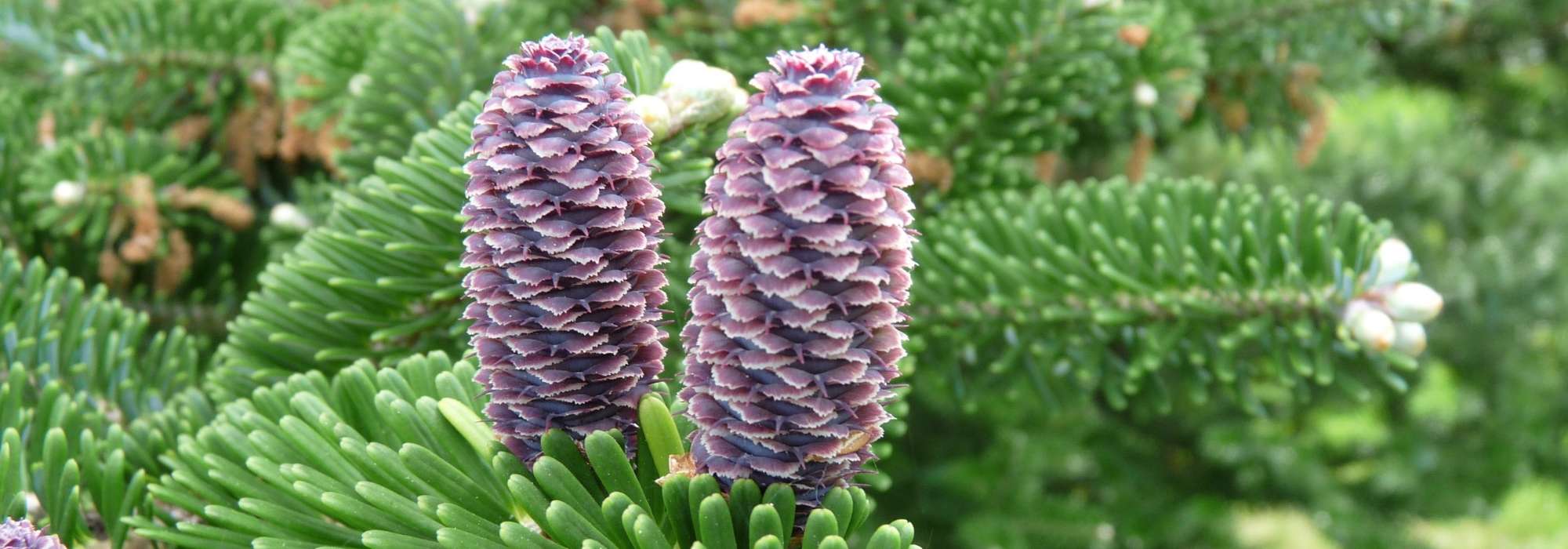
Fir, Abies: planting, pruning and care
Contents
Fir or Abies, in a nutshell
- Fir trees called Abies by their scientific name are resinous evergreen conifers with pyramidal habit,
- They generally inhabit cold, humid high-altitude forests or coastal areas.
- They have fairly short, soft thorns or needles, arranged in two ranks or in a brush and marked with two white bands on the underside, as well as upright cones, tinged with purple in Korean fir.
- Usually large, many fir varieties have slow growth and low vigour, are very attractive and really easy to grow in drained soil, sheltered from scorching sun.
Word from our expert
The tall, noble fir known by its Latin name Abies remains a key element of a successful Christmas atmosphere in the image of the Nordmann fir. It symbolises, through its verticality, the link between earth and sky, thus celebrating renewal since its cutting originally corresponded to the winter solstice according to a Celtic tradition.
These evergreen conifers, with slow growth, have the advantage of retaining their needles longer than the common spruce (Picea abies) when displayed in the living room. Contrary to spruces, the often-flat branches of fir bear supple needles, soft to the touch and upright cones, whereas spruces have sharp needles arranged spiralled all around twigs and pendulous cones. Firs display aromatic needles ranging from dark green as in Abies nordmanniana or Abies omorika to bluish-grey as in the noble fir (Abies procera, syn. nobilis). Cones are very decorative, especially on the Korean fir, a modest-sized fir, rather bushy, reaching 9 m in height and producing cones from a young age of a beautiful blue-violet colour.
Firs most often benefit from slow growth except for a few exceptions such as Vosges fir (Abies alba), whose initially slow growth suddenly accelerates from its 6th year, reaching 1 m per year to produce a tree 45 m tall. Giant fir (Abies grandis) is a “phenomenon” capable of growing 16 m in 20 years and reaching 90 m on Vancouver Island. Offered cultivars are of modest size ranging from 0.50 to 6 m in height with varied habits: bushy, globose, conical to pyramidal.
Firs are generally very hardy and fond of cool conditions, which they seek out and find in upland areas or by the seaside. Easy to grow in the garden, they most often require fresh, deep, well-drained soil and a sunny or semi-shaded aspect. Aphids exude a honeydew on their needles much appreciated by bees, producing an excellent honey. Firs, with some exceptions, tolerate little pollution and high heat.
Description and botany
Botanical data
- Latin name Abies
- Family Pinaceae
- Common name Colorado fir, Spanish fir, Silver fir, Vosges fir
- Flowering between April and May
- Height between 0.30 and 90 m
- Sun exposure sun or partial shade
- Soil type any deep, cool, well-drained soil, sometimes even calcareous
- Hardiness excellent to average (-34 to -15 °C)
Genus Abies groups nearly fifty species of evergreen conifers of family Pinaceae to which pines and spruces also belong. Douglas fir belongs to another genus Pseudotsuga menzieisii, recognisable by its pendulous cones provided with bracts bearing three points. Abies are generally large trees recognisable at a distance by their slender conical silhouette and by their elongated upright cones at branch tips instead of being pendulous as in genus Picea or Pseudotsuga.
Most firs grow in upland areas with cool or cold climates or near the sea such as Vancouver fir (Abies grandis) and noble fir (Abies procera), and occur exclusively in Northern Hemisphere, notably in China and western North America. Some species are however found on mountain summits in tropical regions of Central America and Southeast Asia, and a few rare species are perfectly adapted to drought such as Spanish fir (Abies pinsapo) and Cephalonia or Greek fir (Abies cephalonica).
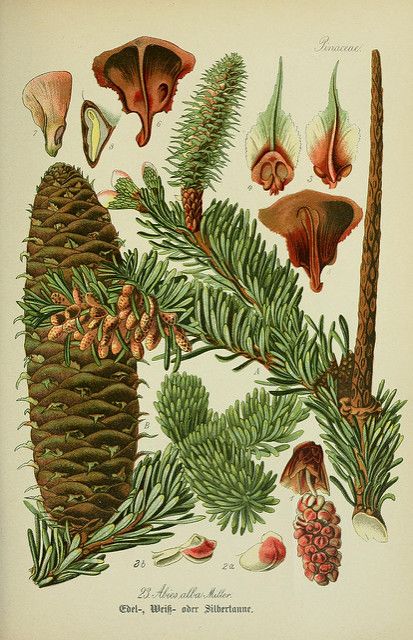
Abies alba – botanical illustration
Firs have a cylindrical trunk that is smooth, grey and covered with resin blisters until bark hardens with age. Branches regularly spaced around trunk in whorled tiers give this conical silhouette much appreciated for highlighting Christmas decorations. Firs’ buds are generally round. Firs often live for more than two or three centuries; growth is generally slow during first 10 years and then accelerates, except in dwarf varieties offered for ornamental gardens.
Firs’ needles are short leaves (1 to 7 cm long) , flat and stiff but not prickly, with blunt or sometimes notched tips, most often arranged in two ranks and with two white bands of stomata (movable cells allowing gas exchange) on underside. However Abies pinsapo, koreana and basalmea are exceptions with their short brush-like needles distributed all around the shoot and with white bands on both faces. Abies bracteata, native to a restricted area of California, is a distinctive species that bears long prickly needles and buds as pointed as those of beech. Bluish-grey tones are often much sought after and result from selections among wild populations, as in Colorado fir (Abies concolor), noble fir (Abies procera) or Spanish fir (Abies pinsapo).
Quick tip to tell a spruce shoot from a fir shoot: Pull on a needle: if a piece of bark is torn away, it is a spruce; if a neat round scar remains on the shoot, it is a fir.
Fir flowering is monoecious, male aments yellowish, greenish or reddish and laden with pollen open in April or May towards base of tree on one-year-old shoots. Female flowers or conelets located on branches at tree top form after fertilization cylindrical upright cones that detach or disintegrate scale by scale under effect of summer drought or squirrels, leaving an upright axis on the shoot. Cones are sticky, exuding droplets of resin at maturity and take one year to mature. They bear bracts more or less protruding, particularly long and tapered in Abies bracteata giving them a hedgehog-like appearance. Triangular seeds are winged and have short germination longevity.
Fir is valued for its pale wood, easy to work both for construction, joinery and for paper pulp. Vosges turpentine is extracted from resin of common fir (Abies alba) as well as an essential oil from its needles used to treat respiratory infections.
Fir honey is strongly aromatic and balsamic with a faint resin scent.
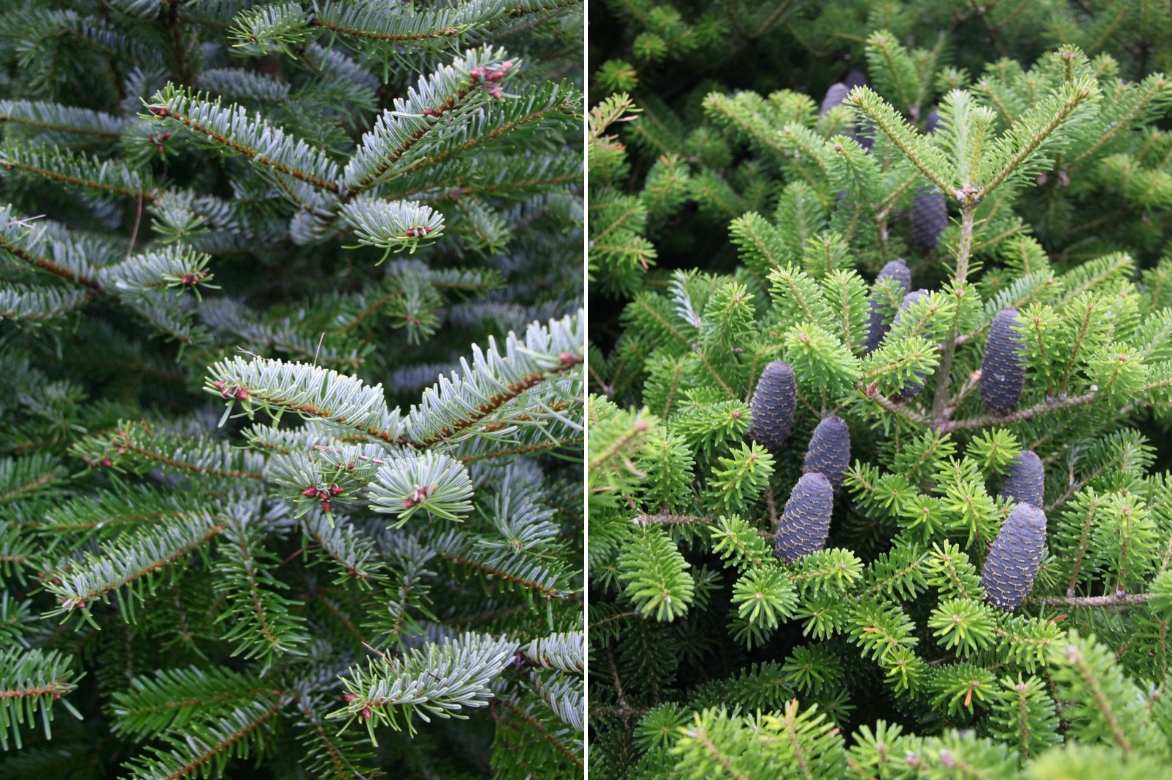
Abies nordmanniana (famous Nordmann fir) / Abies koreana
Read also
Major diseases and pests of conifersMain fir varieties
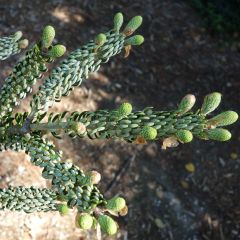
Abies koreana Silberlocke - Korean Fir
- Height at maturity 3,50 m
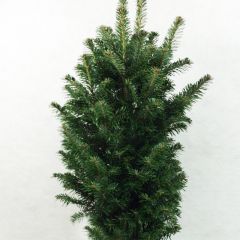
Abies alba Pyramidalis - Dwarf White Fir
- Height at maturity 2,50 m
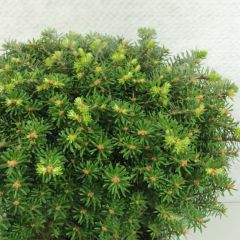
Abies koreana Nadelkissen - Korean Fir
- Height at maturity 35 cm
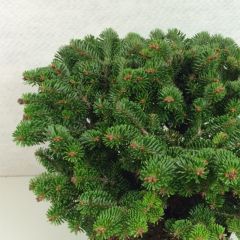
Abies nordmanniana subsp. nordmanniana Münsterland - Fir
- Height at maturity 30 cm
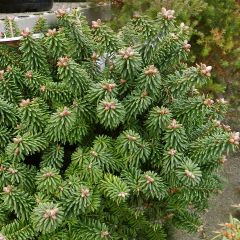
Abies balsamea Piccolo
- Height at maturity 45 cm
Discover other Abies
View all →Available in 1 sizes
Available in 1 sizes
Available in 1 sizes
Available in 2 sizes
Available in 1 sizes
Available in 1 sizes
Available in 1 sizes
Available in 1 sizes
Available in 1 sizes
Available in 1 sizes
Planting
Where to plant fir?
Firs grow in any deep, cool, well-drained ordinary soil. Some species, however, do not tolerate calcareous soil such as nobilis and grandis, unlike nordmaniana and pinsapo, for example. The latter even tolerate dry soils and make very attractive specimens in southern France.
Nikko fir, Abies homolepis, is one of the few to tolerate urban pollution and drought. It rarely exceeds 5–10 m in height and produces young bright-purple cones from an early age, as does koreana, a species also highly ornamental but more demanding.
When to plant?
Prefer planting in autumn between October and December to ensure good establishment before facing summer drought.
How to plant?
This plant is easy to grow if planting is done with a little care. Fir should be planted from a rootball or container-grown specimen but never from bare roots.
- Soak the rootball in a bucket of water to fully moisten it and loosen the outer roots slightly to prevent them from circling, without disturbing them too much.
- Dig a hole 0.60 to 1 m wide and 0.50 to 0.70 m deep and aerate the soil around it with the tines of a digging fork.
- In heavy soil, add a few shovelfuls of sand and gravel to ensure good drainage around the roots.
- It is not advisable to add manure or compost because the plant is content with relatively poor soil. Add shredded horn if the soil is very poor.
- Position the plant only 5–6 cm below soil level.
- Install a stake at a slant or three vertical stakes to support the plant in strong winds.
- Refill the hole and firm the soil lightly, forming a basin.
- Water copiously and mulch if necessary.
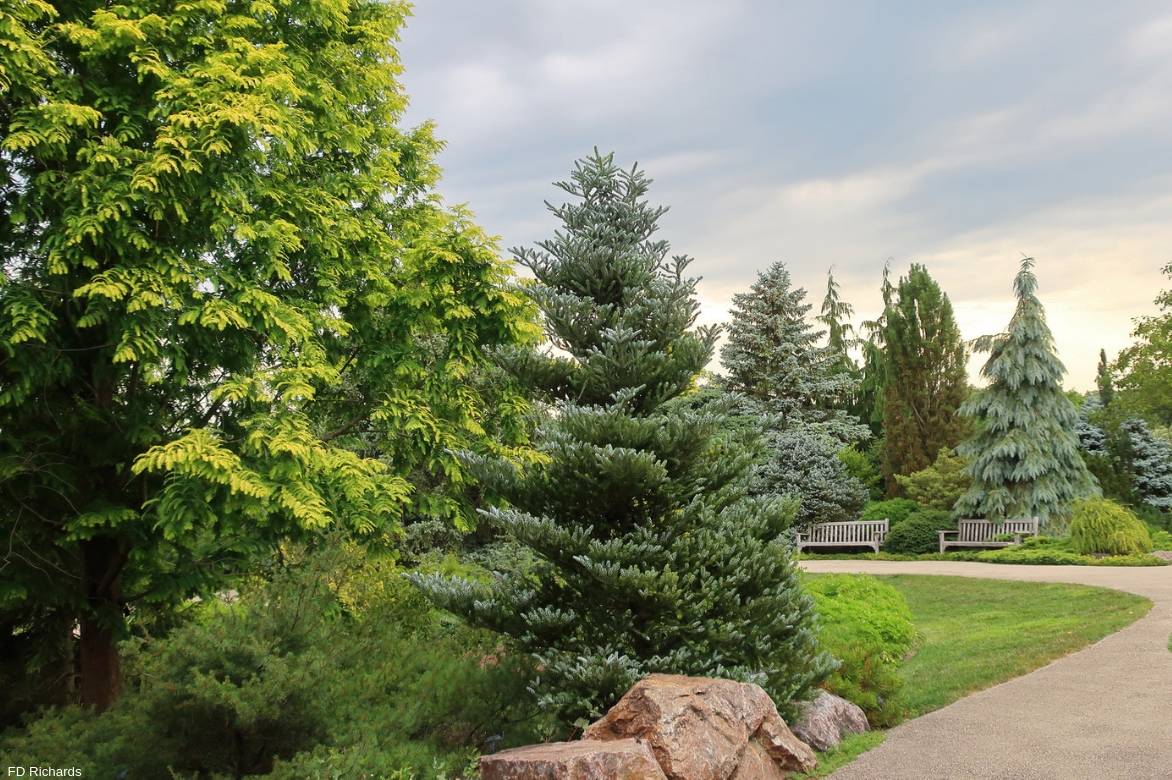
Metasequoia glyptostroboides ‘Gold Rush’, Abies koreana ‘Silver Show’ (variety close to ‘Silberlocke’) and Picea engelmannii ‘Blush’s Lace’ in the background at Chicago Botanic Garden
Read also
How to take cuttings from conifers?Care and pruning
Firs are not pruned to preserve their beautiful conical habit. However, lower branches tend to die back through lack of light, and you can anticipate this by gradually lifting the crown, except for ball-shaped, spreading or bushy forms. It is acceptable to rebalance the profile by cutting a few small branches in October, bearing in mind that the tree does not produce new shoots on old wood.
Firs are susceptible to Chermes aphids, which induce small galls on shoots and, above all, honeydew on foliage, much appreciated by bees. If necessary, spray mineral oil on the trunk in late winter. Rust and red spider mite may occur in dry climates. Firs can also succumb to Armillaria (honey fungus) in poorly drained soil.
Propagation
Simplest propagation is sowing type species, as blue-needled colour forms are often selections that will not necessarily be found in offspring. Propagation by cuttings with a heel from lateral shoots is practised on dwarf varieties, or grafting is used, but this is a matter for professionals.
Propagation by cuttings
Prepare a deep pot by filling it with potting compost mixed with sand.
- Take August-ripened lateral shoot tips by pulling to obtain a heel.
- Remove needles from near base of cutting.
- Insert them two-thirds of their length, ensuring they do not touch.
- Firm gently all around to eliminate air pockets and ensure good contact between potting compost and cutting.
- Place them under cover in a warm, humid atmosphere.
- In autumn, separate rooted cuttings and plant them in deep pots.
- Plant young plants the following autumn in open ground.→ Discover our tutorial : How to take cuttings from conifers?
Sowing
- Sow seeds after harvest in autumn in a sandy mix or cold-stratify for spring sowing.
- Maintain cool conditions.
- Prick out young plants in September.
Uses and companion planting in the garden
Growing in deep pots of dwarf varieties or with very slow growth such as Abies balsamea Nana or even koreana is possible. These are, of course, suitable for small gardens benefiting from a humid atmosphere such as by the seaside or in the mountains. The palette of bluish or lime-green foliage in spring, adorned with brightly coloured cones as in the Korean fir, works wonders in a rock garden where graphic forms — globular, conical or spreading — can express themselves. It can be an alpine rockery planted with very colourful ground-covering perennials such as aubrieta, cerastium, or a rockery planted with heathers.

Planting combination for a bed: Abies balsamea ‘Nana’, Sedum ‘Purple Emperor’, Spirea thunbergii ‘Fujino Pink’, Rosa chinensis ‘Mutabilis’ and Berberis thunbergii ‘Atropurpurea’
Dwarf firs, associated or not with other small rockery conifers, can serve as a setting for small roses, flowering bushes such as azaleas, clumps of peonies, or even wispy grasses with a very complementary temperament. They are plants of character, benefiting from great longevity and requiring no maintenance provided they are well watered during prolonged dry spells.
The slightly more vigorous conical specimens can be planted singly, in threes or in a large windbreak hedge. These plants of strong personality provide long-lasting structure to a bed, define paths, edge the patio, easily substituting for the strong presence of clipped box.
Did you know?
Latin name Abies probably has a pre-Indo-European origin and occurs in most Romance languages (abeto in Spanish, abete in Italian) except in Romanian and French. The word ‘sapin’ comes from Gaulish sapo and is the origin of the name Savoie, which literally means ‘forest of firs’. Famous chain SPAR is named after the fir in Dutch, hence its stylised fir-tree logo.
Further reading
Discover:
-
- Our range of firs
- Firs: discover the benefits of different varieties.
- Discover our tutorial: How to propagate conifers?
Frequently asked questions
-
What to do with my Christmas tree sold with or without its root ball?
Christmas trees sold at Christmas are generally large, pyramidal trees that are difficult to integrate into and grow in an urban garden. That is why planting a Christmas tree such as a Nordmann fir or noble fir, bought with its rootball, in your garden is always tricky, especially when it has been kept in a heated interior. Some retailers take them back to turn them into compost. It should be remembered that growing trees for festive purposes tends to have a positive impact on the environment compared with buying an artificial tree made from petroleum, all the more so since young plantations absorb more carbon dioxide than mature forests. If you wish to plant your tree in the ground, give it sufficient light and a cool atmosphere so that it does not dry out. Ideally, move it outside at night or keep it outdoors while you wait to plant it.
- Subscribe!
- Contents
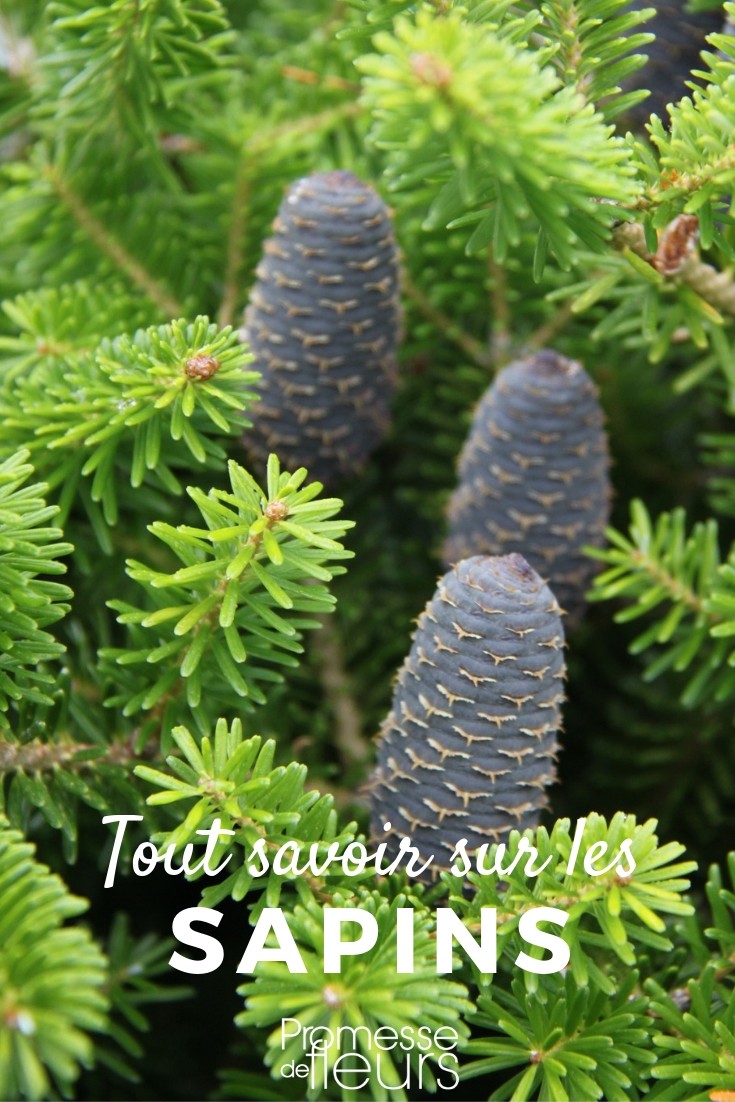

































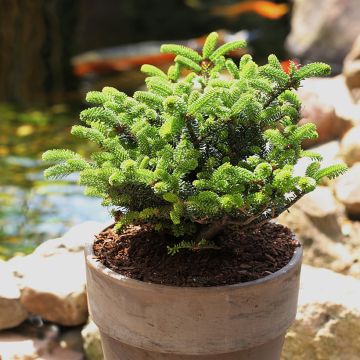
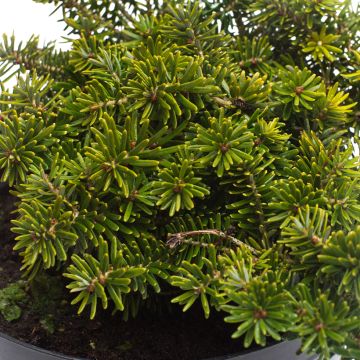
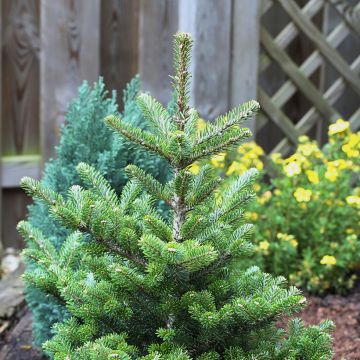

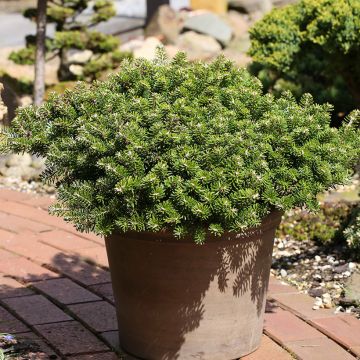
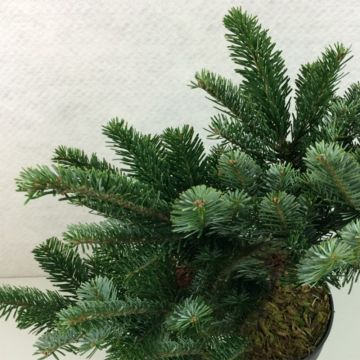
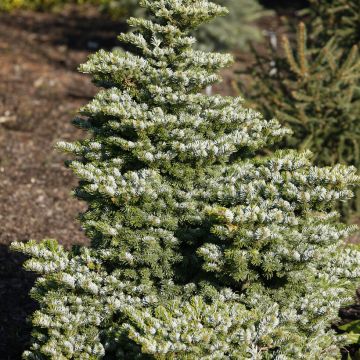

Comments